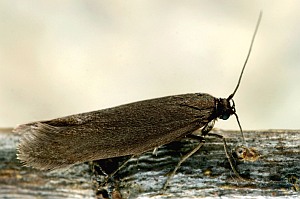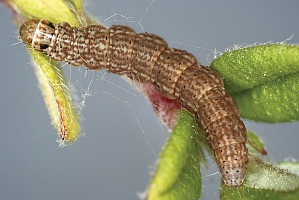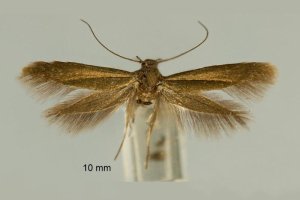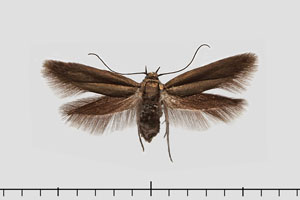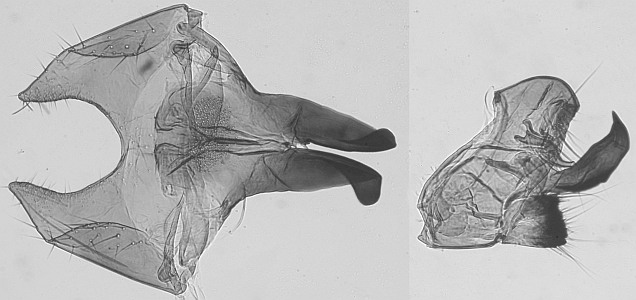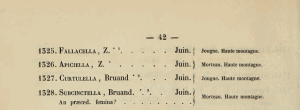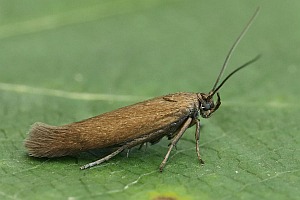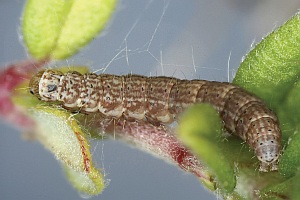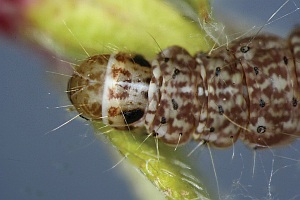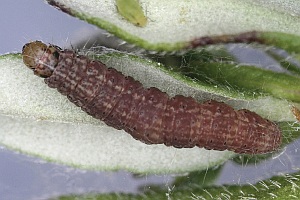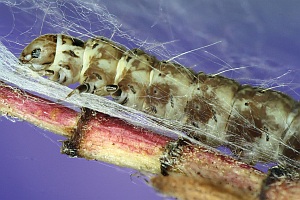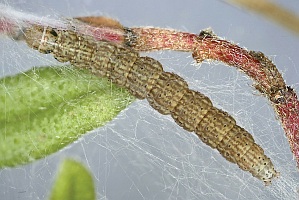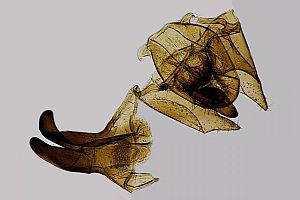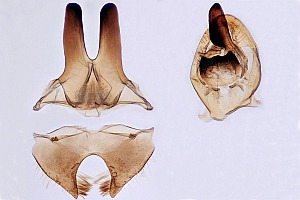

 +12Kontinente:EU
+12Kontinente:EU1. Lebendfotos
1.1. Falter
1.2. Raupe
2. Diagnose
2.1. Männchen
2.2. Weibchen
2.3. Genitalien
2.3.1. Männchen
4, ♂: Deutschland, Nordrhein-Westfalen, Marsberg, NSG Hasental-Kregenberg, 360 m, am Tag gekeschert, 18. Juni 2019 (leg., det., Präparation & Mikrofoto: Dieter Robrecht) [Forum]
Genitalabbildungen z.B.: Bengtsson, B.: Microlepidoptera of Europe (2): Sycthrididae, 1997, p. 246 (♂), p.272 (♀)
2.4. Erstbeschreibung
2.5. Beschreibung als Oecophora crassiuscula
3. Biologie
3.1. Phänologie
Die Imagines fliegen bei Tag von Juni bis Anfang August.
3.2. Nahrung der Raupe
- [Cistaceae:] Helianthemum nummularium [= Helianthemum vulgare] (Gewöhnliches Sonnenröschen)
Die Raupen leben an Sonnenröschen; alle bisherigen Angaben beziehen sich auf Helianthemum nummularium (Zusammenstellung und eigene Angaben bei Heckford & Beavan (2019)).
4. Weitere Informationen
4.1. Andere Kombinationen
- Butalis subcinctella Bruand, [1851] [Originalkombination]
4.2. Synonyme
- Oecophora crassiuscula Herrich-Schäffer, [1855]
- Scythris crassiuscula (Herrich-Schäffer, [1855]) [synonymisiert durch Delmas, 2016]
- Butalis disqueella Fuchs, 1903
- Scythris fletcherella Meyrick, 1928
4.3. Faunistik
Locus typicus ist Morteau im Osten Frankreichs.
Locus typicus des Synonyms Scythris crassiuscula nach Herrich-Schäffer, [1855]: „Mombacher Haide“: Deutschland, Rheinland-Pfalz, Mainz-Mombach, NSG Mainzer Sand.
Rákosy & Goia (2021: 211) schrieben zur (angeblichen?) Meldung aus Rumänien: "It was mentioned in Romanian fauna by Passerin d՚Entréves (in: Karsholt & Razowski 1966) based on its distribution pattern. We do not know any other reports."
(Autor: Erwin Rennwald)
4.4. Publikationsjahr der Erstbeschreibung
Wir folgen den Ausführungen von Viette (1977). Ebenso gibt Delmas (2016: 158) 1851 als Publikationsjahr an.
4.5. Literatur
- Erstbeschreibung: Bruand, T. (« 1850 ») [1851]: Catalogue du Doubs (suite). Tinéides. — Mémoires de la Société libre d'émulation du Doubs 3 (3), livraisons 5-6: 23-69. Besançon (Outhenin-Chalandre fils).
- Delmas, S. (2016): Examination of the Scythrididae in the Bruand d’Uzelle collection: faunistic and taxonomic implications for the genus Scythris (Lepidoptera, Scythrididae). — Nota lepidopterologica 39 (2): 151-167 [Digitalisat auf nl.pensoft.net].
- Heckford, R. J. & S. D. Beavan (2019): Scythris subcinctella (Bruand, [1851]) (Lepidoptera: Scythrididae): changes to the scientific name and observations on the larva in England. — Entomologist's Gazette 70 (4): 199-207.
- Heppner, J. B. (1982): Dates of selected Lepidoptera literature for the western hemisphere fauna. — Journal of the Lepidopterologists' Society 36 (2): 87-111.
- Beschreibung als Oecophora crassiuscula: Herrich-Schäffer, G. A. W. („1853-1855“) [1847-1855]: Systematische Bearbeitung der Schmetterlinge von Europa, zugleich als Text, Revision und Supplement zu Jakob Hübner's Sammlung europäischer Schmetterlinge. Fünfter Band. Die Schaben und Federmotten: 1-394, Tineides pl. 1-124, Pterophides pl. 1-7, Micropteryges pl. 1. Regensburg.
- Meredith, G. H. J. (2012): Scythris crassiuscula (Herrich-Schäffer) (Lep.: Scythrididae) bivoltine in the Cotswolds. — The Entomologist's Record and Journal of Variation 124 (4): 167-169.
- Rákosy, L. & M. Goia (2021): Lepidopterele din România: lista sistematică și distribuție. The Lepidoptera of Romania: a Distributional Checklist. — 369 p.; Cluj-Napoca (Presa Universitară Clujeană).
- SCHÜTZE (1931): 141
- Steeman, C. & T. Sierens (2018): Interessante waarnemingen van Lepidoptera in België in 2017 (Lepidoptera). — Phegea 46 (2): 31-47. [PDF auf phegea.org]
- Viette, P. (1977): Le catalogue des lépidoptères du Doubs de Théophile Bruand. — Bulletin mensuel de la Société linnéenne de Lyon 46 (8): 283-288 [PDF auf linneenne-lyon.org].













